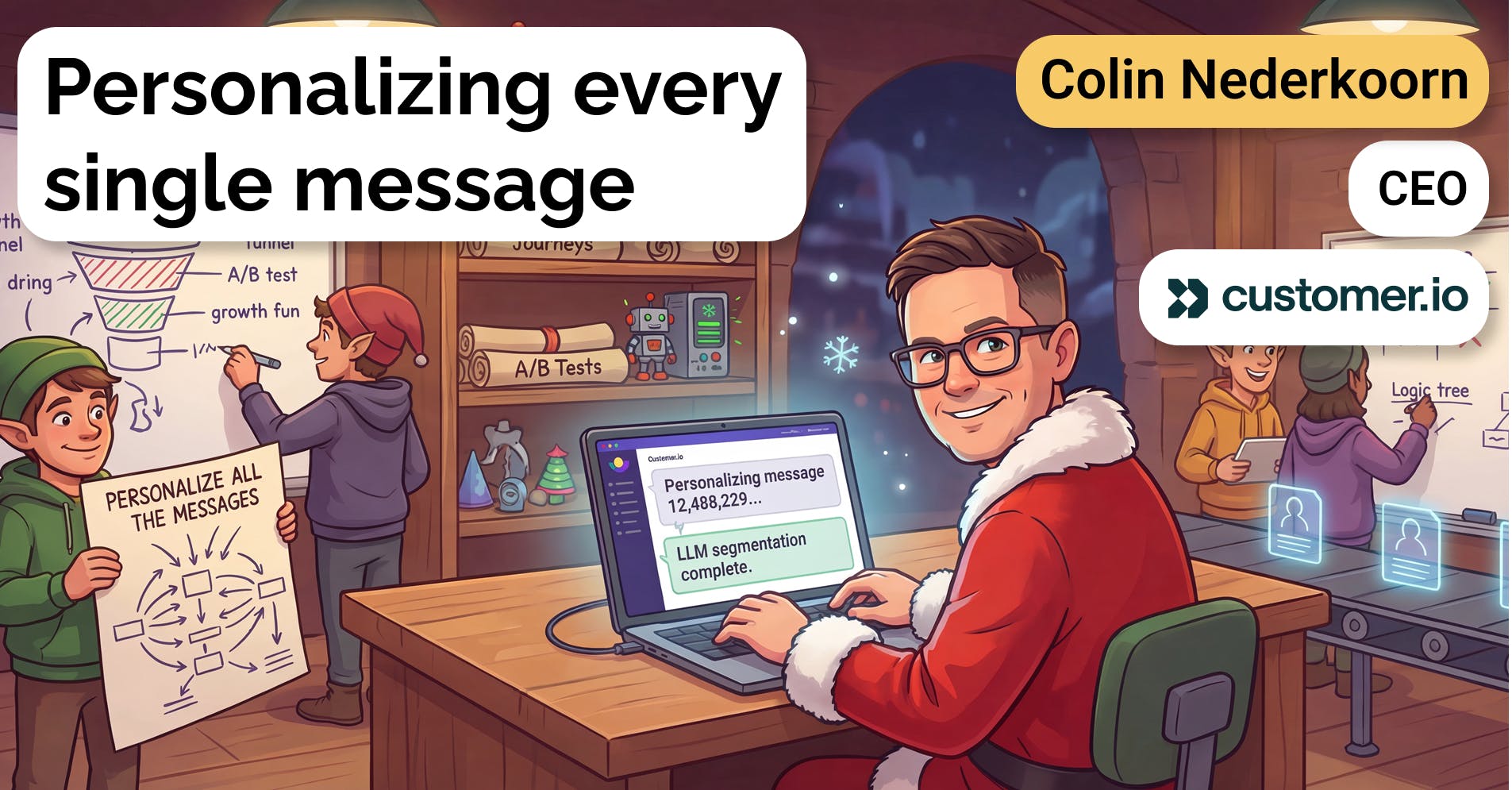Startup co-founder on building a customer communication workflow
 Jan-Erik Asplund
Jan-Erik Asplund
Questions
- What brought you guys to Customer.io and were there alternatives that you considered?
- Can you say more about what the problem was?
- How did it match up to Customer.io on features and flexibility?
- It strikes me that it was a problem for your team, because your marketing team couldn’t use the tool once your developer had left.
- Can you maybe talk a little bit about your use cases for email generally?
- I’m interested in Segment’s role in your workflow, especially now as they’re owned by Twilio, but also because of how—as you just talked about—they make it easy to pack up and leave your email platform.
- And you’re paying a comparable amount for ActiveCampaign that you were for Customer.io?
- Was the ability to merge user identities the straw that broke the camel’s back or do you think you might have stayed a customer had that been different?
- I would love to hear more about how you’re thinking about integrating more of the customer experience into that one place.
Interview
What brought you guys to Customer.io and were there alternatives that you considered?
Guest: Yeah, so I can tell you about the arc of our journey with them. We were on Drift before Customer.io. Okay. And this was before Drip pivoted into the e-commerce space. The product didn't fundamentally change, but they very strongly signaled that they were pivoting to e-commerce.
And so we went looking for a new solution because we also weren't that happy with Drip and—I've never met anyone who was an in-house marketer who has happy with their ESP—but we wanted some features that were missing that we wanted to take advantage of.
And Customer.io seemed to have everything that we needed in the context of us having a marketing developer in house who could instrument all of it.
We had a full-time developer who was dedicated as a dedicated marketing resource. And part of the reason for us to move into Customer.io was that it was extremely flexible if you had dev hours to throw at it. And that's what led us to making the switch. We also looked at MailChimp, we looked at HubSpot, on the higher end of the market, and we looked at ActiveCampaign. We looked at ConvertKit, and I think that was the primary mix. And then we moved to Customer.io.
It's not a marketers interface, so it's not, I didn't spend a ton of time in it. It was essentially owned by the marketing developer and when we needed to build campaigns, automations, like I went in and I did it, but ultimately most of our marketing system ran off of custom code triggered automations.
In late 2019 we parted ways with our marketing developer and we no longer have that in-house resource. And it became this huge time suck for managing Customer.io, because when we wanted to instrument new events or when we wanted it to change how things were structured, it would just take us a lot of time.
And then there was also a major shortcoming that had been a problem since we started, but that we had lived with.
Our business model is a free trial to paid subscription model. And what happens with our business and with many businesses like ours that have free trials is we'll have people that'll sign up for three or four free trials over the course of their journey, and then eventually convert to paid.
And very often a customer might have three, four different email addresses that they've created to use us. And Customer.io actually had no way to merge them, no way to map them together. And so we could never get a clear view of what the customer journey looked like for those kinds of customers.
Can you say more about what the problem was?
Guest: Customer.io has this concept of an immutable customer ID. And everybody that signs up gets this immutable customer ID. And you just can't merge two customer IDs together. It may be on the roadmap, but that was a big kind of blind spot that we ended up with in our data because we just, we couldn't map those profiles together. So with the lack of ability to merge accounts and with the dev lift that was required to now manage the Customer.io account, we didn't have the bandwidth for it, and we decided to look for something a little bit more appropriate for our needs. And that’s how we ended up switching to ActiveCampaign in January, which we found had come a very long way since the last time we demoed it.
How did it match up to Customer.io on features and flexibility?
Guest: Yeah, to be honest it's far more flexible than I thought. And I can't think of anything we did in Customer.io that we can't do an ActiveCampaign.
The last time that I had demoed ActiveCampaign was like $200 million in funding ago, and since then they've built out something really powerful. And I would say at this point they are less of a MailChimp competitor and more of a HubSpot competitor with this kind of full suite marketing automation platform.
And I've been extremely impressed with it. And yeah, so we're able to do everything with it.
Probably the API is less flexible. If we wanted to do something extremely technical and unique, we may find that we run into a blocker there, but that’s not something we've seen yet. But we can set up behavior based automations in ActiveCampaign.
Also, everything we ever did in Customer.io ran through Segment. And so anything we ever instrumented as a segment of that was something we could automate. We could like basically trigger things off of it in Customer.io. And there is now an extra step where if we want to automate based on behavior, we still have to instrument that event in ActiveCampaign.
But we still run stuff through segments. I guess there's just an extra step. And in my mind, and again, this is without a really comprehensive expert view of the landscape, but the way that I see Customer.io is what I don't mean this in a pejorative sense at all, or in a negative sense at all, but that it's what your developer comes back with when you send them shopping for an email platform.
It strikes me that it was a problem for your team, because your marketing team couldn’t use the tool once your developer had left.
Guest: Yeah. And I guess, it depends on who they want to target because there are certainly companies that are up-market from us that will always have those developer resources. There's always gonna be somebody in some technical growth marker role that's going to own the automation and maybe it's fine for them, but just for our size, it just didn't feel like a fit with the resources that we had.
Can you maybe talk a little bit about your use cases for email generally?
Guest: Yeah. So there are a few different use cases that we have for email. The first is customer activation and conversion. So whenever somebody signs up for a trial they'll get onboarding emails, kind of nudges to upgrade, to convert.
And then after they convert, they'll get some nudges to take different actions within the product.
The second use is marketing communication. So sending out content, sending out announcements about webinars, sending out announcements about our events, any kind of marketing communications that we need to do, we'll do through our email platform.
The third is affiliate management. So we manage all of our affiliate partnerships through our ESP.
The fourth is just ongoing customer communication. So when we announce new features, when we announce updates to the product, pricing changes, those kinds of things, that all goes through one place.
And it was something that we used to run through multiple platforms. But that also created a lot of a few different headaches for us, and streamlining that into one platform was highly advantageous for us.
I’m interested in Segment’s role in your workflow, especially now as they’re owned by Twilio, but also because of how—as you just talked about—they make it easy to pack up and leave your email platform.
Guest: Yeah, I was actually talking yesterday or two days ago to a marketer who is shopping for an ESP, and her company has for quite some time used SendGrid as their marketing platform, and she was just complaining about how extremely limited it is. I think just got the ability to like A/B test subject lines, something that MailChimp had in 2011.
But yeah, so I think that's where my view on it being commoditized came from or partially is influenced by, because there's no real moat when you're piping everything through Segment and you can pack up and leave very easily like you said.
For a very long time, email platforms have had extremely high perceived switching costs. Like people think that moving email platforms is really hard and it's a huge lift and stuff's going to get broken in the process and it's gonna be really challenging. The reality is most of these platforms make it extremely easy these days. And if you're paying enough money, and I don't mean enterprise deals. Like for us, we're paying a few hundred dollars a month. They'll do it all for you. They migrated everything for us. Our automations, they rebuilt those, they rebuilt our forms, they rebuilt our segments.
They migrated everything for us. So it was really easy. And having Segment that already pipes in all your data, like you said, it's just there's no real lock-in.
I think there probably are companies that get more value from Customer.io than we get from ActiveCampaign. I just think we weren't a great fit. And I think that like the lack of marketing dev resources, and then also the free trial to paid model, I think were probably the two things that made us not a great fit for them.
And you’re paying a comparable amount for ActiveCampaign that you were for Customer.io?
Guest: Yeah, similar to Customer.io, which we were paying something around $500 or $600 per month.
Was the ability to merge user identities the straw that broke the camel’s back or do you think you might have stayed a customer had that been different?
Guest: Yeah, for us it was pretty much the straw that broke the camel's back.
I think it's possible that if that weren't an issue, we could have gritted our teeth and gotten through it, but it was still something where we felt that there was something missing. And especially with this push to streamline our communications and take customer communication and bring it into our ESP as well, it just wasn't going to be possible with Customer.io set up the way that we had it.
I would love to hear more about how you’re thinking about integrating more of the customer experience into that one place.
Guest: What's interesting is that these features might exist in Customer.io, but we just, I couldn't find them. Because I think it was like we looked for that and we tried to make it work, but you probably have to write some code to do it.
So now we have all of our trials and partners and paying customers in one place on ActiveCampaign. Lead scoring is a big thing, so being able to score and segment our leads based on intent and where they come in from. That's really big for us because we have many different entry points for coming into our brand and they almost always will have different kinds of intent.
For example we have these extremely bottom of the funnel competitor comparison pages where somebody will come in from Google and then maybe they'll sign up for our email list. And that is somebody who is going to convert with very different messaging than the person that lands a long-form piece of content we produce, and hasn’t even touched the software side of things yet, or isn't even thinking about software.
So being able to segment leads based on that and put them into the appropriate automations, and then being able to actually assign scores to leads. And then surfacing leads that are really close to converting, but might need like a one-on-one nudge, which is something that ActiveCampaign does facilitate and it has a CRM built into it.
So if somebody is interacting with a bunch of our content and is interacting with a bunch of our feature pages but hasn't converted yet, they get pulled into a separate list where I can go in and send them a template or a one-on-one email or automate a template or a one-on-one email to go out and say, “Hey, how can I help,” like, “Look, can we get on the phone and chat for a few minutes to learn about what it is that you're looking for?” So, I think having those things is really valuable.
ActiveCampaign also makes forms really easy. So you can just copy and paste a JS snippet and have an email collection form on your site really easily.
So those, yeah, like those kinds of things, it's like that full life cycle of of nurturing and of conversion that we didn't really take advantage of on Customer.io at all.
Disclaimers
This transcript is for information purposes only and does not constitute advice of any type or trade recommendation and should not form the basis of any investment decision. Sacra accepts no liability for the transcript or for any errors, omissions or inaccuracies in respect of it. The views of the experts expressed in the transcript are those of the experts and they are not endorsed by, nor do they represent the opinion of Sacra. Sacra reserves all copyright, intellectual property rights in the transcript. Any modification, copying, displaying, distributing, transmitting, publishing, licensing, creating derivative works from, or selling any transcript is strictly prohibited.









